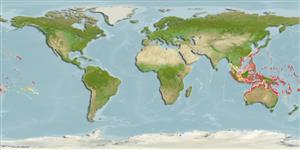>
Eupercaria/misc (Various families in series Eupercaria) >
Lethrinidae (Emperors or scavengers) > Lethrininae
Etymology: Lethrinus: Greek, lethrinia, a fish pertaining to genus Pagellus.
More on author: Seale.
Environment: milieu / climate zone / depth range / distribution range
البيئة
بحري مرتبطة بالشعاب; غير مهاجرة; نطاق العمق 2 - 30 m (Ref. 2295), usually 2 - 18 m (Ref. 37816). Tropical; 31°N - 32°S, 96°E - 134°W
Pacific Ocean: Indonesia and Philippines, north to southern Japan, south to Australia, east to the Tuamoto Islands. Has most frequently been named Lethrinus mahsena.
Length at first maturity / الحجم / وزن / العمر
Maturity: Lm ?, range 28 - ? cm
Max length : 50.0 cm TL ذكر/ مختلط الجنس; (Ref. 48635); common length : 32.5 cm TL ذكر/ مختلط الجنس; (Ref. 2295); العمر: 24 سنين (Ref. 2290)
الأشواك الظهرية (المجموع): 10; الأشعة الظهرية الناعمة (المجموع): 9; شوكة شرجية 3; أشعه شرجية لينه: 8.
Inhabits seagrass beds and sandy areas of lagoons and outer reef slopes. Found singly or in schools. Feeds mainly on crustaceans, mollusks, and fish. Marketed fresh (Ref. 9775).
Life cycle and mating behavior
النضج | التكاثر | وضع البيض | بيض | الخصوبة | Larvae
Gonochorism is inferred for this species as sizes of males and females overlapped and male gonad morphology is typical of secondarily derived testes (Ref. 103751). Juvenile hermaphroditism is exhibited by this species (Ref. 35994).
Carpenter, K.E. and G.R. Allen, 1989. FAO Species Catalogue. Vol. 9. Emperor fishes and large-eye breams of the world (family Lethrinidae). An annotated and illustrated catalogue of lethrinid species known to date. FAO Fish. Synop. 125(9):118 p. Rome: FAO. (Ref. 2295)
IUCN Red List Status (Ref. 130435)
استخدامات بشرية
مصائد: غير مهمة تجارياً; لعبة سمكه: نعم
مزيد من المعلومات
مراجعالأستزراع المائيملف الأستزراع المائيسلالاتجينيElectrophoresesالتوريثالأمراضمعالجةNutrientsMass conversion
أدوات
تقارير خاصة
Download XML
مصادر علي الأنترنت
Estimates based on models
Preferred temperature (Ref.
123201): 25.1 - 29.3, mean 28.6 °C (based on 2744 cells).
Phylogenetic diversity index (Ref.
82804): PD
50 = 0.5000 [Uniqueness, from 0.5 = low to 2.0 = high].
Bayesian length-weight: a=0.01585 (0.01028 - 0.02443), b=3.00 (2.88 - 3.12), in cm total length, based on LWR estimates for this species & Genus-body shape (Ref.
93245).
مستوى غذائي (Ref.
69278): 3.8 ±0.0 se; based on diet studies.
المرونه (Ref.
120179): وسيط, الحد الزمني الأدني لتضاعف عدد أفراد المجتمع 1.4-4.4 سنة (K=0.29-0.31; tm=3.7-5; tmax=24).
Prior r = 0.49, 95% CL = 0.33 - 0.74, Based on 1 stock assessment.
Fishing Vulnerability (Ref.
59153): Moderate vulnerability (35 of 100).
Nutrients (Ref.
124155): Calcium = 44.1 [31.1, 63.0] mg/100g; Iron = 0.829 [0.557, 1.158] mg/100g; Protein = 20.3 [17.7, 22.5] %; Omega3 = 0.123 [0.088, 0.169] g/100g; Selenium = 37.1 [20.8, 58.2] μg/100g; VitaminA = 30.9 [6.9, 161.8] μg/100g; Zinc = 2.07 [1.59, 2.64] mg/100g (wet weight);
